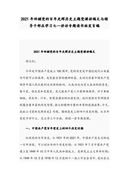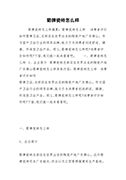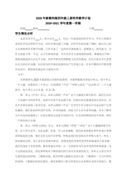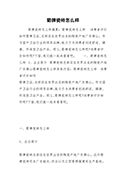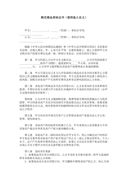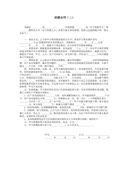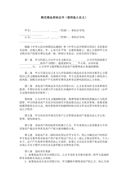《牛津小学英语》Unit 7 of 3A(精选15篇)三年级英语教案
《牛津小学英语》Unit 7 of 3A(精选15篇)
《牛津小学英语》Unit 7 of 3A 篇1
全国小学英语观摩课教案 指导教师:胡澄宜 开课时间:2003/10/25执 教:金 蓉听课对象:全国部分英语教研员及英语教师教学内容:《牛津小学英语》unit 7 of 3a教学目标:1. 复习关于服装的词汇:jacket, coat, blouse, dress, sweater, t-shirt, skirt, shirt, smart, pretty2. 复习句型:look at my/his/her coat. it’s smart/pretty/cool/nice. thank you.3. 复习字母aa---nn4. 复习字母缩略词:kfc, cd, cba, bbc, cctv, 5. 学习字母oo及字母缩略词wto6. 学习开音节单词的拼读。7. 通过学习,提高学生听、说、读的综合运用能力, 逐步了解中英文化的差异。8. 通过有规律地学习,使学生掌握有效的学习方法,逐步掌握英语单词的 拼读规则。9. 通过说说、唱唱、演演、做做、读读等活动,使学生快乐地学习英语。10.研究英语儿歌在小学英语教学中的作用。教学重点:1. 复习关于服装的词汇。2. 复习句型:look at my/his/her coat. it’s smart/pretty/cool/nice. thank you.3. 学习字母oo及字母缩略词wto4. 学习开音节单词的拼读。教学难点: 1. 能正确熟练地运用句型look at my/his/her coat. it’s smart/pretty/cool/nice. thank you.进行交际,并逐步了解中英文化的差异。2. 学习开音节单词的拼读。 教学准备:教师: 1. 制作多媒体课件 2. 带数样漂亮的玩具、文具等物品。3. 录音机、磁带4. 准备字母卡片 学生: 1. 带数样漂亮的玩具、文具、服装等物品。2. 穿平时最漂亮的衣服。teaching steps:step 1. free talk.1. 师生快速连环问答。step 2. review the drills. look at my/his/her …. it’s …. thank you.1. 教师示范:以教师身边的漂亮玩具、文具导入。例:t: hello, boys and girls. look at my toy dog/new watch/new pencil-box.s: it’s nice/pretty/lovely.t: thank you.2. 学生小组练习。3. 配乐时装表演:挑选数名学生当时装模特儿上台表演,其余的学生在座位上自由谈论模特儿的服装,最后请3---5组学生汇报。4. 英语儿歌表演唱: look at his coatlook at his coat. it’s very smart.look at his shirt. it’s very nice.look at her blouse.it’s very strange.look at her dress. it’s very cute. step 3. review the letters.1. read the letters.cc ll aa dd ee mm hh bb ff ii kk nn gg jj2. read the abbreviations.(图文并茂)kfc cd cba bbc cctv step 4. learn the letter oo.1. read the abbreviation “wto”.(导入新授字母oo)2. learn the letter oo.3. learn the new words. (图文并茂) bone home rose nose4. read the chant.oo o, o, it’s a bone. o, o, it’s a home. o, o, it’s a rose. o, o, it’s a nose.5. chant and sing.oo o, o, it’s a bone. it’s a big bone. bone,bone, a big bone. the dog likes the bone.6. make your words.(用字母拼搭单词游戏)7. read the words. name nice notelake bike lodecake like codegame life tonelate side vote step 5. chant and sing. (letter aa—oo)step 6. homework.1. make new dialogues using the pattern drills “look at…. it’s…”.2. chant and sing letter oo.
《牛津小学英语》Unit 7 of 3A 篇2
一、教学内容:《牛津小学英语》1blet’s learnlet’s play
二、教学目标:
1、能听懂、会说、认读以下八个有关颜色的单词: red、blue、yellow、green、pink、purple、brown、orange;
2、能用what colour is it? it is…进行问答。
三、教学重点:八个有关颜色的单词
四、课前准备:
1、师:水彩笔、彩色卡纸、彩色气球、磁带;
2、生:水彩笔、纸。
五、教学过程:
1、warming-up
(1)sing a song;
(2)greeting with everyone;
(3)ask some question, call some student answer it。
2、presentatio
(1)show a red colour chalk to students
t: what colour is it?
s: red.
t: yes, it’s red (write the word on the blackboard) follow me [red](repeat three times)
(学生在幼儿园时对有些颜色单词有过初步的认识,所以可试着通过学生的口引出单词,如果不知道则由教师引出,以下几个颜色单词的教授也如此)
(teach the word “blue” in the same way)
(2)ask a student on the yellow clothes
t: what colour is it?
s: yellow
t: right! it’s yellow (write the word on the blackboard) follow me [yeleu](s repeat it, say it one by one)
t: look, chen wear a green clothes. (write the word on the blackboard) follow me (s repeat it, say it group by group)
(3)show students a pink balloon
t: what colour is it?
s: it’s pink.
t: good! it is pink (write the word on the blackboard) follow me (s repeat it, say it one by one)
(teach the word “purple” in the same way)
(4)show student a brown colour card
t: what colour is it?
s: it is brown.
t: yes, it is brown. (write the word on the blackboard) follow me (s repeat it, say it with other words)
(teach the word “purple” in the same way)
3、practice
(1)listen to the tape and read after the tape while look at the word;
(2)work in group of 4:one say a colour, the other three point at the right colour card as quickly as possible;
(3)play a game : guess what colour it is?
t: (hide a colour card, then say) what colour is it? guess!
s: it is red
t: no, it is green./ yes, you are right.
4、consolidation
(1)put all the colour cards together , then ask the students say them out one after another;
(2)look at the words and read them out;
(3)do what teacher say: teacher say a colour ,all students draw the right colour on the paper, then show it。
5、homework
(1)do the workbook ;
(2)say out the colours in your bedroom, then tell them to your parents。
六、教学反思
1、采用歌曲、师生交谈的方式开始一堂课是激发学生兴趣,活跃课堂气氛的有效途径;
2、采用通过粉笔、学生穿着的衣服、气球、有色卡片等多种教学手段创设情景引出新知识,能够有效地吸引学生的注意力,使新授的过程不至于太呆板;
3、运用游戏巩固新知识是本节课的特点,取得了良好的教学效果;
4、由于学生人数较多,教学中操练速度与密度要把握好一个度,做到点面结合。
《牛津小学英语》1b unit 3 colours 来自98e范文网。
《牛津小学英语》Unit 7 of 3A 篇3
教学内容:c部分 work in pairs
教学目标:
1、能听懂、会说、会读、会写句型do the boys jump higher than the girls? does jim swim slower than david?及其答语。
2、能正确看懂图意,并能灵活运用。
教学重点:能当堂掌握四会句型do the boys jump higher than the girls?does jim swim slower than david?
教学难点:区别do 以及does的不同用法,明确助动词后面动词用原形。
教具准备:幻灯片、图字卡、计时器(以便游戏时计时)、小星星(上面写着well done.以激励学生)。
教学过程:
step1 review
1. 把单词补充完整,并说说单词的中文意思。(幻灯片出示)。
l____w ( ) ____ ____rly( ) w____l____( )
l___t___( ) str___n____( ) f___ ____t ( )
你知道这些单词的比较级怎么写吗?
2. 游戏“碰地雷”。
游戏规则:读小黑板上的单词,在其中一词下面“埋”一颗地雷,读到该词时不能读出声,否则将被地雷“炸掉”。
游戏目的:巩固新单词的读音。
3. 合作游戏 (句子接龙)
游戏规则:每组抽一张图字卡、第一个学生说出一个词,第二个学生补充。比如s1:fast s2:run fast s3:ben runs fast s4:ben runs fast than jim。
游戏目的:巩固副词比较级的用法,增强语言学习趣味性。
step2 presentation
1. read, match and write
①questions:(幻灯片出示)
a. do the dogs swim slower than the ducks?
b. does the bee fly higher than the bird?
c. do the tigers run slower than the pandas?
d. does the rabbit jump farther than the cat?
②find the difference.找不同。
仔细读幻灯片中的句子,体会四个句子间的相同点与不同点。
③use the dialogues above as models, then make a sentence.
引导学生分别以do, does开头问两句话,体会do, does的不同用法。
注意,助动词后动词用原形。
2. check the answers.(上一节课的家庭作业练习册第9页)
3. read the sentences.
4. look, complete and answer.
_______ the boys jump higher than the girls?
________jim swim slower than david?
看图,填空并回答。
在回答的过程中,学习答语yes,…do / does. no,… don’t / doesn’t,及其句式he swims faster than david.
5. practise in pairs.
6. 换词练习
do the boys ______ ______ than the girls?
does jim ________ ________ than david?
a. work in groups.
b. check.
step3 work in pairs.
talk with your partner. use the dialogues above as models. the words in the box will help you.
fast slow high low
early late well fat
1. read the words in the box.
2. oral work:talk with your partner.
3. writing work.指导写话
指名上台板书八句话(最好写在幻灯片上)。
注意纠正学生句子中一些拼写或语法上的错误。
4. play a game:快言快语
游戏规则:小组内每人读板书中的一句话(例句两句、外加八句练习中的,共十句话),并计时,全部读完用时最少的一组获胜,每人将得到一颗写有well done的小星星。
游戏形式:小组内合作、小组之间竞争。
游戏目的:巩固所学四会句型,培养英语脱口而出的能力,增强合作与竞争的意识。
step4 consolidation
1. 完成补充习题第5页,d. look and write
①look and read by yourselves.
②discuss in groups.
③write the answers.
④check the answers.
2. play a game:musical chair 抢椅子
游戏规则:
小组活动,每次有5个学生参与,只摆放4把椅子。
①放音乐,学生围着椅子走。
②音乐停,学生坐到椅子上。没有坐上椅子的那一个学生被淘汰、被罚说一段对话,模仿练习册d部分。
③顺利完成任务的学生、奖励一枚写有well done的小星星。
游戏目的:
巩固所学句型,增强英语学习的趣味性。
step5 布置作业
1. 听力练习。listen and tick 完成补充习题第4页
2. 书面作业,仿写句子。(书上第17页)
3. 预习a部分课文。
板书内容:
四会句型do the boys jump higher than the girls? does jim swim slower than david?及其答语。
板书设计:
《牛津小学英语》Unit 7 of 3A 篇4
unit 1 who is younger?
单元教材分析:
本单元的主要话题是两种事物的比较,通过ben, jack和su hai之间的闲聊引出本单元的主要语言项目:形容词比较级。教师可创设情景,用实物或动作将比较级的概念清晰明了地传播给学生,同时注重比较级单词的读法与写法规律。
教学目标:
1.能听懂会说、会读、会写单词tall, young, old, heavy。
2、能听懂会说、会读单词和词组twin, minute, centimeter, child, also, chat。
3、能听懂会说、会读日常交际用语:i’m as tall as you. su yang’s twenty minutes younger than su hai. whose school bag is heavier, yours or mine?
4.能听懂、会说、会读、会写句型who’s taller then david? gao shan is taller than david。
5.了解字母组合or在单词中读音。
6.会唱歌曲i wish i was taller。
教学重点:
1.能掌握本单元的四会单词、句型。
2.灵活运用形容词的比较级于真实情景中。
教学难点:掌握形容词比较级的读写规律及用法。
教具准备:录音机.磁带.挂图.图片.相关的实物等。
课时安排:第一课时:b. look read and learn c. work in pairs
第二课时:a. listen, read and say
第三课时:c. work in pairs d. listen and write
第四课时:e. look, read and judge 练习册a部分
第五课时:f. play a game g. listen and repeat 练习册b部分
第六课时:h. sing a song 练习册c.d.e.f部分
友情提示:
1.注重各环节中的情景设计.本单元重点学生形容词及其比较级用法。教学中,教师在每个环节中都要注重对情景的设计。利用实物进行比较,让学生对比较级有直观清晰认识。另外本单元牵涉到人物的比较,教学中可联系学生实际进行语言交际,让学生在真实的交际中体会语言,学习语言。
2. 注重对语法知识的渗透讲解.学生刚接触比较级对其用法易模糊,特别对于“…than…”和“…as…as…”两句型易混淆,因此教学中教师有必要对学生对此句型进行简单梳理,讲清两句型特点及区别。(详细内容见教参)
3. 注意对“who’s(比较级)than…?”和“whose…is(比较级)?”两句型的区别讲解,在教学中学生对这两句型的构成易混淆,教师要注意在新授时帮助学生理清句式特点及句意。
《牛津小学英语》Unit 7 of 3A 篇5
教材简析:
“planning for the weekend”是译林版《牛津小学英语》6a unit6part a,主 要 教学内容是关于娱乐活动类的单词词组,和一般将来时在句中的应用。要求学生围绕这类词组在一定的语境下用“be going to”进行说话,并能在实际生活中熟练地使用,真正让教材服务于生活。设计思路:本节课利用多媒体辅助教学,培养学生学英语的兴趣。通过屏幕呈现动画歌曲“will you join me?”把学生引入课堂教学中。热身运动复习旧知识,也给新课学习作了铺垫。课上教师通过创设真实或半真实的情景与学生进行语言交际,学习、运用本节课词组和句型。“体态语”的运用,座位以小组为单位的排列,为学生创设轻松愉快的英语学习环境,有利于发挥学生最大的能动性。通过课件学习本节课“周末计划”的教学内容,并以各种形式由浅入深的强化训练来巩固课文内容。在拓展运用阶段,让学生通过打电话这一真实的情景进行交际运用,把语言真正应用于实践,做到“学以致用”,最后渗透思想文化教育。
教学目标:
1 能正确地听、说、读、写单词和词组plan, play, have school,take part in 和句型what are you going to... ? we are going to...
2 能正确地听、说、读单词和词组concert, opera, singing contest 和句型is that gao shan? yes, speaking. by the way, what are you going to do... ?
3 能根据图片提供的情景进行描述。
教学重点与难点:四会单词及句型的拼读和运用。
课前准备:
1 教具准备:单词图片、与奥运会有关的福娃图片和国旗、五环旗以及多媒体课件。
2 学生准备:事先布置学生预习本单元的单词。
3 板书准备:预先写好课题unit 6 planning for the weekend
教学过程:
i. classroom management
(歌曲导入,激发兴趣,热身运动,引入新知)
1. listen to a song “will you join me?”
(歌曲能把学生的注意力很快吸引到课堂上来,做好上课前的一切准备。)
2. free talk
t: what day is it today?
what date is it today?
what’s the weather like today?
it’s warm and sunny. let’s do some exercise.(引导学生复习学过的活动类单词及词组。)
3. warming up exercise
t: follow me, please. (多媒体课件上呈现各种运动的场景,教师引导学生边说边做动作。)
t: run, run, running. i like running.
ss: run, run, running. i like running.
t: fly, fly, flying. flying a kite.
ss: fly, fly, flying. flying a kite.(老师说半句,让学生完成下半句,培养学生大脑思维的灵活性。)
t: surf, surf, surfing.
ss: surfing the internet...
(运用体态语及各种操练形式,复习打球类运动、演奏乐器类以及娱乐活动类的词组。)
ii. presentation and practice
(复习导入,联旧引新,自然过度,强化操练。)
1. introduction
t: boys and girls, we have lessons from monday to friday. theyare weekdays. but we don’t have lessons on saturdays and sundays. they are weekends. we don’t have school at weekends.
(板书、操练)
t: i usually do housework at weekends. but this weekend,i’m going to go shopping.
t: what are you going to do this weekend? (板书、操练)
s1: i’m going to go to the park this weekend. (t: good!)
(表扬学生,每发言一次,就奖励一张福娃贴画)
t: (to s1) please ask him.
s1:(to s2)what are you going to do this weekend?
s2: i’m going to do housework this weekend .(t: very good! ) (to s3)
what are you going to do this weekend?
s3: i’m going to play basketball this weekend. (t: well done!) …
(屏幕上呈现各种图片,为学生提供说话的材料)
t: who can ask me the question?
s4: what are you going to do this saturday, miss yin?
t: i’m going to visit the zoo. by the way, what are you going to do this saturday? (板书)
s4: i’m going to …
2.practice and then acting out the dialogue
(幕上呈现多幅娱乐、运动等画面以及句型,师生之间进行强化操练后,学生两人一组讨论周末计划并在小组内进行充分地操练,然后以问答的形式师生、生生、小组之间表演对话。)
eg. --what are you going to do this weekend?
--i’m going to play basketball. (替换词)
by the way, what are you going to do this weekend ?
--i’m going to go to a farm.
t: today we are going to learn “planning for the weekend”
(呈现课题, 并操练)
3 . learn part a of unit 6
a introduce the text.
(通过声音、图片、体态语渗透新内容,并进行操练)
a. t: now, boys and girls, listen carefully. what’s the sound? can you guess? (钢琴声)
yes, the sound of the piano. (课件呈现南希弹钢琴图片,运用体态语) nancy can play the piano. she is going to play the piano at the concert this weekend. (板书、操练)
b. but david can’t. what can he do?
(课件呈现大卫拉小提琴及琴声。)
ss: david can play the violin.
t: good. you are right. he is also going to play the violin at the concert.
c. (师唱京剧片段) what’s song?
ss: (京剧)
t: yes, you are right. it’s beijing opera. do you like to see a beijing opera? (板书及操练)
ss: no, we don’t.
t: i’m sorry. but i like seeing beijing operas.
b. listen, read and say
a. (多媒体播放课文第一部分内容,然后请学生回答问题)
(多媒体呈现语言材料,显得生动、形象、逼真,能引起学生的有意注意,容易激发求知欲,有利于他们更深刻地感知和准确、牢固地记忆所学知识。﹞
what are gao shan and david’s plans for the weekend?
what are they going to do ? let’s listen and watch carefully and find out the answers.
q: what’s the weather like there?
q: do the children have school today?
q: what are they talking about?
b. (阅读课文,根据课文内容判断正“t”误“f”。)
david is going to see the beijing opera with us. ( )
he is going to meet us at six in front of the garden theatre. ( )
...
c. (讲解语言点,角色朗读,然后填写下列表格)
(学生填完表格后,老师检查答案)
(精讲重难点,强化训练;朗读操练,培养学生纯正的语音语调;表格填写,培养学生自主学习和总结概括的能力)
plan for saturday
who : gao shan and his dad, david
plan : see a beijing opera
where : the garden theatre
when: on saturday afternoon plan for sunday
who :david /nancy/gao shan
plan :play the violin /play the piano /go and watch the concert
where:at the concert /at the concert /in the school
when:on sunday afternoon
d. (根据表格内容,让学生复述课文)
(复述课文能加强学生对所学知识的记忆,增强学生的自信心和成就感,提高他们的英语口头表达能力。)
iii. consolidation
(创设情境,巩固新知,角色对话,提高口语会话能力。)
1.(电话铃声,把学生的注意力引导到现实生活中来)
t: i’m sorry, boys and girls. my friend is calling me.
can i answer the phone?
ss: ok.
a: (接电话) hello!
b: hello! is that jenny?
a: yes, speaking.
b: what are you going to do this sunday?
a: i’m going to see a beijing opera.
by the way, would you like to join me?
b: yes, i’d love to.
a: that’s good. see you this sunday.
b: see you.
(电话内容也是教师给学生操练对话内容的示范。)
2.(示范表演对话,分组强化操练,鼓励角色表演。)
(分组活动体现了面向全体的教学原则,使每个学生都能得到参与,都有均等的学习机会,体现了以学生为主体的原则,也增强了小组和班集体的凝聚力,操练可以加强对对话内容的进一步理解。分组活动学生由于无心理压力,交谈环境宽松,因而乐于说话,讲话能力也得到了提高。)
iv. strengthen
(联系生活实际,自由运用对话,渗透思想教育,提高综合素质)
(多媒体画面呈现北京奥林匹克图标及五个福娃的图片,让学生讨论你为奥运会将做些什么?)
1. t: boys and girls, when is the olympic games held?
sa: it’s on …
2. t: what’s liu xiang going to do during the olympic games?
sb: he is going to …
3. t: is yao ming going to take part in the olympic games?
ss: sorry, we don’t know.
t: but we hope he is going to be better soon.
4. t: what are you going to do for the olympic games?
sd: i’m going to do more exercise to get stronger.
se: i’m going to …
(师生交流,并以一首奥运歌曲结束课文。)
(学生每回答一个问题,就奖励他一幅福娃的图片或一面国旗、奥运旗,激发学生踊跃讲英语的热情。通过学生们的热烈讨论,我们将课堂教学延伸到学生的生活实际,真正做到“学以致用”,提高了学生的语言运用能力,也把这一课推向高潮,把学生的思想升华到一个更高的境界。)
v. homework
1.和同学、家长讨论,你为奥运将做些什么?
2.打电话问一问你的亲戚朋友,他们的周末计划是什么?
在下一课上告诉大家。
板书设计: unit 6 planning for the weekend
what are you going to do this weekend?
i’m going to ...
have school
beijing opera
by the way
at the concert
【参考文献】:1、《英语课程标准》(实验稿)中华人民共和国教育部制定
2、《小学英语教学法教程》王蔷
教学反思:
六年级课文较长,光通过听录音,模仿、跟读、示范、操练、角色表演等实施教科书上的内容是远不能达到《新课程标准》的要求。针对教学内容,我抓住本课的重点与难点,利用小步子,快节奏,勤反复的教学方法,根据“由浅入深,由易到难,循序渐进”的教学规律, 精心设计课堂教学,强化单词、词组及句型的操练。利用表格中的“关键词”让学生复述课文,把书上静止、单调、枯燥无味的文字通过多媒体辅助教学,转变为说话的能力,激发了学生的求知欲。分组活动学生由于无心理压力,交谈环境宽松,因而积极主动地参与学习,提高了英语交际能力。物质与精神鼓励能增强学生的自信心和成功感。他们获得成功,又有了新的追求,再获得新的成功,这种良性循环带来了好的学习效果,并产生了长远的积极作用。思想教育的渗透,能培养学生热爱祖国、热爱集体,关心他人,乐于助人的好品质,提高他们的综合素质。
《牛津小学英语》Unit 7 of 3A 篇6
教学内容:
1、b部分单词:an e-mail, a fax machine, a telephone number, an e-mail address。
2、c部分第2、4、6幅图。
教学目标:
1、能听懂、会说、会读单词和词组an e-mail, a fax machine, a telephone number, e-mail address。
2、能熟练地听、说、读、写句型can i have…? what for? i want to…。
教学重点:
熟练地运用句型can i have…? what for? i want to…表达索要某种物品。
教学难点:单词machine的发音。
教具准备:单词卡片、句型卡片、磁带、挂图。
教学过程:
step 1 warm up
1、greeting.
2、sing a song: i wish i was taller.
3、duty report.
请学生拿出前一课布置准备的谜语,念给同学们猜。
4、revision
①出示b部分单词卡片,开火车读单词,遇到四会单词要拼写,看哪一组火车可以不断,即为获胜组。
②出示c部分句型卡片,集体朗读句子,读完后贴在黑板上。
step 2 presentation
1、teach: an e-mail.
该词在5b就已学过,在这里教师中需要出示单词卡片集体认读两遍,注意强调e-mail的字母全是小写。
2、teach: e-mail address.
①t: my e-mail address is ×教师顺势板书于黑板。
②出示卡片,教师范读address,分节读ad-dress→address。
③学生齐读address。
④开火车读e-mail address。
⑤教师询问: what’s your e-mail address?
⑥同桌互问,构成信息差。
3、teach: a fax machine.
①出示图片后,教师简单介绍传真机多应用于公司,家庭中不常用。
②教师范读a fax machine,特别是machine的发音,教师要多做几遍示范,从不同角度向学生们展示发音口形。
③学生分组读machine, machine, fax machine。
④指名读。
4、teach: a telephone number.
t: my telephone number is what’s your telephone number?
通过这个问句检查学生理解程度,telephone number虽未出现过,但两个单词学生都理解,因此这个词不论从认读和理解词义来说都不难。
step 3 consolidation
1、先听录音,再模仿跟读,最后指着单词按录音顺序齐读。
2、小组合作,四人为一组,分别读b部分词汇,请其他成员查找错误并纠正。
3、play a game: a good memory.
游戏规则将b部分挂图的每一物品标号、一学生说序号,请另一学生不看,而只凭记忆说出其相应单词。
step 4 look and say
1、教师引导学生读黑板上的句型。
a: can i have a/ an some…?
b: what for?
a: i want to…
b: sure. here you are.
2、教师可与学生作示范。
t: can i have a post card?
s: what for?
t: i want to write to tim.
s: sure here you are.
3、任务型活动
游戏规则:教师将全班学生分为a、b两个大组,每组分别担任不同的角色,如a组担任班级的“材料保管员”,b组负责完成教师布置的任务。教师可设计“writing to teacher”,“drawing a picture”,“making a kite”等任务,b组学生在完成以上任务时首先向a组领取材料,在此过程中,a、b两组学生必然要用can i have…? what for? i want to… sure. here you are等句子进行交流,在完成各自任务的过程中自然运用语言。
4、回到课本中,请学生两人一组,操练c部分第二、四、六幅图。
5、指名两至四组表演对话。
6、同桌合作,用身边所有的学习用品来操练本部分句型。
7、教师范写第二幅图。
8、学生模仿练写第四、六幅图,教师巡视指导。
9、指名读自己所写的句子。
step 5 homework
1、听b部分录音半小时,跟读单词各五遍,预习a部分二十分钟。
2、自选c部分(二、四、六图)两幅图写下来。
3、自由扩充c部分句型。
板书内容:1、 unit 7 a letter to a penfriend.
2、单词
e-mail address:
telephone number:
3、句型
a: can i have a/ an/ some ?
b: what for?
a: i want to .
b: sure. here you are.
板书设计:
《牛津小学英语》Unit 7 of 3A 篇7
教学内容:《牛津小学英语》6b unit 3 asking the way g listen and repeat及h sing a song。
教学目标:
1. 了解字母组合ou在单词中的读音,培养学生整体认读,记忆单词的能力。
2. 有表情地演唱歌曲excuse me。
教学重点:
1. 培养学生能灵活运用或扩充本单元所学的对话。
2. 正确掌握字母组合ou在单词中的读音。
教学难点:正确朗读含有ou字母组合的单词。
教具准备:本单元的单词卡片、磁带、录音机、玩具老鼠、女式衬衫。
教学过程:
step 1 warm up
1. greetings.
2. sing a song:excuse me
①朗读歌词。
②让学生跟着录音机学唱歌曲。
③分组比赛演唱歌曲。
④自编动作表演唱。
3. free talk.
①师生进行问路对话示范。
t:can you tell me the way to…, please?
s:yes,…
t:how far is it from here?
s:it’s about…away.
t:how can i get there?
s:you can take…and get off at…
②学生之间进行问路对话,分组比赛。
step2 revision.
1. 学生拿出课前准备好的听写本、听写本课四会单词和句型。
2. 分段复述或背诵a部分内容。
3. 对话表演a部分。
step3 listen and repeat.
1. 利用玩具老鼠和女式衬衫导入g部分的学习。
t:guess, what’s in the blouse?(touch and guess)
s:…mouse.
2. 出示g部分的单词blouse, house, mouse, out,让学生自由读,并体会字母组合ou在单词中的读音。
3. 听录音,跟读单词。
4. 归纳ou字母组合在单词的发音:ou—/ au /。
5. 出示本部分的句子,指导学生朗读,理解句子意思,并试着背诵。
6. 与学生一起归纳、整理其它含有字母组合ou并发/ au /音的单词。
mouth, shout, about, playground, cloudy
step4 consolidation
1. chant:where’s the bookshop?
2. sing the song:excuse me.
3. 在黑板上画城市交通图,让学生根据实际情况看地图问路,灵活运用本单元的日常交际用语。
step5 homework
1. 朗读本课会话,要求学生能够复述、背诵表演。
2. 有感情地演唱歌曲:excuse me
板书内容:unit 3 asking the way
ou—/ au /:blouse house mouse out
mouth shout about playground cloudy
板书设计:
《牛津小学英语》Unit 7 of 3A 篇8
教学内容:e. look, read and judge.补充练习a部分
教学目标:
1.能听懂、会说、认读单词centimeters。
2.通过观察、朗读、训练学生阅读理解语篇的能力,并能针对问题做出正确判断。
3.通过听力练习,提高学生观察思维及听的能力。
教学重点:能正确流利朗读阅读材料,并理解内容。
教学难点:
1.流利、规范朗读语言材料
2.正确完成听力
教具准备:录音机、磁带、图片、词卡等
step 1 warm up
1. greetings
2. sing a song: i wish i was taller!
3. free talk
利用室内现有物品及学生实际情况,围绕b.c部分的词.句及…as…as…句型与学生间灵活展开对话,以此检查学生对知识掌握情况:
step 2 revision
1. listen repeat and answer(a部分内容)
①on sunday morning. where did su hai go for a walk?
②who did she meat?
③what did they do under a big tree?
④do su yang and su hai look the same?
⑤is su hai as tall as su yang?
⑥who’s younger, su hai or su yang?
⑦does jack have any brothers or sisters?
⑧how old and is jack?
2. look and read
出示b部分图片比较,生说形容词及其比较级。
3.写出形容词的比较级
step 3 presentation
1.导读e部分引言部分,学习goal keeper。
2.生自由朗读。
3.学习165 centimeters。
出示指导朗读,并适当拓展。
4.指生读
5.指导生完成下面的判断
6.read and check
step 4 do exercise(练习册a部分)
1. look at the pictures and talk about them.(可让生同位间进行)
2.listen to the tape.(指导生记录关键词语)
3.listen and repeat.
4. listen and judge.
5. listen and check.
step 5 home work
1. read the text of part a.
2. read and write the words two times.(b部分)
板书内容:
词组:b部分的形容词及其比较级goalkeeper, centimeter
句型:…as…as…
…(比较级)than…
板书设计:
教后笔记:
《牛津小学英语》Unit 7 of 3A 篇9
教学内容:《牛津小学英语》6b unit 3 asking the way b look, read and learn及c look and say。
教学目标:
1. 能正确地听、说、读、写词汇turn left / right, post office, get on, get off, along, street。
2. 能正确地听、说、读词汇shopping, centre, middle school, primary school, train station, history museum crossing。
3. 能正确地听、说、读、写句子can you tell me the way to…, please?
4. 能听懂、会说句型和日常交际用语go along this street,and then turn…at the …crossing.
教学重点:
1. 能正确地听、说、读、写词汇turn left / right, post office, get on, get off, along, street.
2. 能正确地听、读、写句子can you tell me the way to…, please?
教学难点:
1. 能正确地听、说、读写本单元的四会单词和句型。
2. 能运用c部分的句型进行问路的情景对话。
教具准备:本单元的挂图、单词卡、磁带、录音机、场所类卡片及一张城市交通图。
教学过程:
step 1 warm up
1. sing a song:do some exercise with me.
热身运动,师生跟音乐边唱边跳,同时复习turn left和turn right,为后面的教学做好铺垫。
2. listen and do.
show me your right hand / touch your left ear / stand up / turn left / turn right…
step2 presentation and practice
1. 师生对话引入本课话题。
t:liu jing is new here. she comes from fu jian. she wants to buy some books. but she doesn’t know the way to the bookshop. can you help her?
s:sure.
t:good. look at the map of the city.(出示本地区的地图)where’s the bookshop?(教师指着地图,引导学生找到书店的位置并导入新授知识)。
2. 利用地图,师生交流学习句型。
a:excuse me,can you tell me the way to the bookshop?
b:let me see. er,…go along this street, and then turn left at the second crossing. the bookshop is there.
①板书对话内容。
②对板书中出现的生词along, street, turn right / left等进行拼读教学,并让学生理解。
③chant:where’s the bookshop?
bookshop, bookshop, where’s the bookshop?
can you tell me the way to the bookshop?
go, go, go, go along this street, then turn left.
you can see the bookshop at the second crossing.
3. 创设情景,用c部分的句型逐一引出b部分单词。
t:andy is yang ling’s friend. he wants to visit some places. this is his timetable. where will he go? let’s try to tell him how to get there. ok?
①用图表展示andy想去的地方。
time(时间)places(地点)pictures(图片示意)mondayhistory museum配相应的图片(下同)tuesdaypost officewednesdayno.1 primary school thursdayno.4 middle school fridaypost office saturdayshopping centre sundaytrain station
②引导学生学习b部分单词,多音节词可分音节进行教学,出示音标,降低读音难度。
③学生听录音,模仿跟读单词。
④利用look and say的方法引导学生复习b部分的词汇。教师可快速闪动单词图片,让学生用英语说出人物所做的动作或所看到的不同场景。
⑤游戏“开汽车去某处”,在玩的过程中强化记忆get on / get off.
⑥利用简单的路线图配上表示不同场所的图片,运用刚才所学句型进行师生交流,生生交流。
⑦小组内操练对话。
step3 consolidation
1. 教师出示c部分的图片创设情景引出句型的操练。
t:先介绍图片,the park is on your left. 让学生模仿说出其他的地点。
t:can you tell me the way to…, please?
这样学生就很容易回答了,用同样的方法操练其他的地点(shopping centre, bus station, wc…)。
2. 利用情景图,师生示范对话,让学生模仿练习。
3. 让掌握较好的学生做示范,然后同桌问答。
4. 教师板书四会句型,由学生集体朗读。
5. 书写指导。
6. chant:where’s the bookshop?
step4 homework
1. 朗读并抄写要求四会掌握的单词和句子。
2. c部分自选两幅图编对话。
3. 用英语介绍自己所在地区的一处景点(或场所),描述其具体方位。
板书内容:unit3 asking the way
①词汇:turn left / right, post office, get on / off, along, street, shopping centre, middle school, primary school, train station, history museum, crossing。
②句型:can you tell me the way to…, please? go along this street,and then turn left / right at the … crossing. the …is on your… that’s all right.
板书设计:
《牛津小学英语》Unit 7 of 3A 篇10
教学内容: g. listen and repeat h. say a rhyme及练习册
教学目标:
1、熟练掌握四会词汇和句型。
2、了解字母组合ur在单词的读音。
3、有表情地诵读歌谣i want to write a letter。
教学重点:
1、熟练掌握四会词汇和句型。
2、了解字母组合ur在单词的读音,并能扩充举例。
教学难点:正确理解歌谣含义,并能有表情地诵读。
教具准备:挂图、磁带、小黑板
教学过程:
step 1 warm up
1、greeting
2、listen a rhyme: i want to write a letter.
3、revision.
组织学生听d部分录音资料,提问相关问题:
①how old is helen? ②does helen live in nanjing?
③what’s the name of helen’s school? ④what are helen’s hobbies?
回答时学生间可采用男、女间,半班间,同桌间等多种问答形式进行操练。
step 2 presentation
1、listen and repeat
本部分是语言训练项目,教师应指导学生正确朗读单词及句子,并让他们体会字母组合ur在单词中的读音。
①教师让学生自己朗读单词,边读边体会字母组合ur在单词中的读音。
②出示单词hurt, nurse, thursday, turn,集体认读。
③指导学生听录音跟读单词和句子。
④教师引导学生看黑板朗读,也可在学生中展开朗读竞赛,看谁读得又快又准。
⑤鼓励学生自己归纳整理其它例词,编写成绕口令或句子练习朗读。
2. say a rhyme
①教师播放小诗录音,引导学生分句跟读。
②教师与学生按节奏诵读小诗。诵读时可根据节奏和内容做动作,以帮助记忆。
③指名读。 ④小组间试着编歌谣。
step 3 doing exercises
1. listen and number
听录音,根据所听到内容的先后顺序,在相应图中的方框内写上序号。
教师让学生先看图,用英语说出节目名称,再做此练习。
2. listen read and judge
听录音,读句子,根据所听内容判断句意是否正确。
教师让学生先看句子,读懂大意,听录音时注意进行方法指导。
3. look and write
看图,根据上下文完成句子。
教师指导学生边看图边读句子,在此基础上完成此项练习。
4. read and answer
朗读短文,根据短文内容回答问题。
5. read and complete
朗读并完成句子。
6. look, read and write
看图完成句子。
step 4 homework
1、练习册中的e、f两题作为家庭作业。
2、朗读并抄写本单元要求四会的单词各两遍,句子各两句。
3、鼓励学有余力的学生用英语与外籍朋友或其他学校的学生通信。
板书内容:
1、课题:unit 7 a letter to a penfriend
2、单词:hurt, nurse, thursday, turn
3、句型:last thursday the nurse hurt her fingers and they turned black and blue.
板书设计:
《牛津小学英语》Unit 7 of 3A 篇11
教学内容:复习1,2单元,完成书上a部分的练习。
教学目标:
1 学生熟练掌握1,2单元的四会单词及四会句型。
2 学生能根据图片选择相应的日常交际用语,并填上序号。
教学重点:复习一,二单元所学内容。2完成书上a部分的练习。
教具准备:多媒体课件、挂图。
教学过程:
step 1 warm up
1 greetings
2 sing a song. “i wish i was taller”
3 on duty.
step 2 revisions.
1 play games. “animal show”(以闯关的形式,利用多媒体画面设置游戏,让学生在描述画面的过程中复习前两个单元的内容.
(1)课件出示单词,学生认读。
形容词:old--older short--shorter fat--fatter heavy--heavier light--lighter
strong--stronger thin--thinner
副词: low--lower late--later early--earlier early—earlier
far--farther well--better
(2)教师归纳:形容词修饰名词,副词用来修饰动词等。
(3)课件呈现一些动物,让学生运用形容词比较描述动物形体差别。如 the elephant is heavier and stronger than the pig. whose ears are longer, the bear’s or the rabbit’s?
(4)课件呈现动物表演的画面,让学生运用副词单词来谈论这些动物的精彩表演。 如:the birds and the bears all dance well, but the birds dance better than the bears.
step 3 look, match and say.
1出示图片1,学生先讨论画面的内容,再读读句子,然后说说答案。
2 两人一组,讨论其他几幅图。
3交流
4 男女生分角色朗读对话
5 学生适当扩展对话,表演对话。
step 4作业布置:
1 read and write
name:yao ming age:25 height: 226cm weight:134kg
(1)yao ming is ( ) years ( ) than me.
(2)yao ming is ( ) centimeters ( ) than me.
(3)yao ming is kilos ( ) than me.
2 用英语描述自己的最好朋友,并运用比较级把他(她)的特点与自己作比较。
板书内容:
unit 4 review and check
who is taller than ...?
do the ducks swim faster than the fish?
does the rabbit jump higher than the cat?
板书设计:
《牛津小学英语》6b unit 4 第一课时 来自98e范文网。
《牛津小学英语》Unit 7 of 3A 篇12
教学内容:b. look, read and learn. c. work in pairs
教学目的:
1.能听懂、会说、会读、和会拼写单词tall, young, old, heavy。
2.能听、说、读懂本单元中所学的形容词及比较级。
3.能听、说、读句型who’s taller than? is taller than。
教学重点:
1.掌握本部分所学的形容词及其比较级,并能运用于情景中。
2.掌握句型“who’s… than…? whose…is…?”。
教学难点:了解并掌握形容词比较级在语音与字形上的变化。
教具准备:
录音机.磁带.相关实物.图片等
教学过程:
step 1 warm up.
1. listen to a song: i wish i was taller
2. greetings
3. free talk
可围绕以下句型与不同学生展开:hello. good morning! nice to see you at new term. how old are you now? oh, you’re younger than me. look, he is tall. who’s taller than him? look at my scarf. it’s long. the scarf is longer than this ruler(随着手拿一尺子)…
step2 presentation
1. learn long, longer
①由free talk引出long, longer.并出示单词指导生朗读,并比较两词区别其间教师不断地出示实物,边比较边发音long-longer.
②practice in pairs
指导生利用现有实物练说long-longer
2. learn whose…is…, yours or mine?
①教师将围巾与学生围巾放在一起问:whose scarf is longer, yours or mine?并指导生回答。
②practice in pairs
生利用现有实物进行问答练习
③ss act.
3. learn old-older, young-younger
①出示图画,引导生观察,随机出示两组单词指导生朗读。
②操练句型: who’s…than…?
师随意问两个同学的年龄后;指着两个学生问其他学生:who’s older/ younger than…?并引导生回答。
4.出示单词:tall-taller, short-shorter, small-smaller
①引导学生根据发现的规律进行练读。
②总结比较级一般情况下的发音与书写规律。
5.出示big, fat, thin, heavy
①鼓励生写出比较级,并适当出示正确单词。
②强调特殊情况下比较级单词的变化规律。
③指导朗读。
5.拼读old, young, tall, heavy
step3 consolidation
1. listen to the tape and read after the tape.
2. look and read
出示图片进行比较,指导生认读。
3. work in pairs
①picture 1-2,出示挂图,师示范并随机板书句子。
②groups work.
出示相关图片,引导学生进行替换练习。
step 4 homework
1. listen to the tape and repeat.(b部分)
2. write the words of pant b two times.
3. make dialogues use the words.
板书内容:
句子:a: who’s… than…? b: …is.
a: whose…is… , yours or mine? b: …is, i think.
单词:b部分出示的单词
板书设计:
教后笔记:
《牛津小学英语》Unit 7 of 3A 篇13
教学内容:h. sing a song 练习册c、d、e、f部分
教学目标:
1.全面复习巩固本单元所学的单词句型。
2.理解歌曲内容,能准确唱出歌曲i wish i was taller。
3.通过练习,检查学生对所学知识的掌握情况,并以此提高学生的语言实际运用能力。
教学重点:熟练掌握并运用所学的单词、句型。
教学难点:培养学生阅读理解及书写的综合能力。
教具准备:录音机、磁带、图片、词卡等。
教学过程:
step1 warm up
1. greetings
2. sing a song.
①listen to the tape. ②简单介绍歌词大意. ③sing after the tape.(2遍)
3. free talk
结合学生的实际情况及室内现有物品,围绕本单元词句与学生展开闲谈。
step2 revision
1. listen and repeat.(a部分)
2. listen and answer.(d部分)
①who’s younger, su hai’s aunt or su hai’s mother?
②is the man is black su hai’s uncle?
③is su hai’s father stronger than su hai’s uncle?
④who’s older, su hai’s father or su hai’s uncle?
3. listen and write.(b部分形容词及其比较级)
4. look and write. 出示c部分图片,指导生写出对话。
5. choose and write.
bird, girl, skirt, t-shirt
the tall in the yellow and the blue has a .
step 3 do exercise.(练习册)
1. look, read and write(c部分)
①指导看懂题意. ②指导读懂表格内容及句子内容.
可采用问答形式帮助学生理解如:t: who is taller thon jack? who is younger than jack? who is heavier than tom?…
③生自由练习. ④read and check.
2. look and write.(d部分)
①指导生看图,谈论图意。
如:p1: who’s taller the boy or the girl.
p2: who’s stronger, the policeman or the doctor?
p3: who are heavier, the oranges or the pears?
p4: whose hair is longer?…
②生自由阅读并补充句子。 ③read and check.
3. look, read and write.(e部分)
①talk a bout the pictures.
t: what are they? who’s heavier? whose ears are longer? whose nose is shorter? who’s stronger?
②read the passage in pairs.
③complete the sentences. ④read and cheek.
4. read, write and answer.(f部分)
①read the dialogues in pairs.
②指生对话 ③指导理解对话内容
④answer the questions.
a: who is taller than john? b: is marg stronger than john?
c: what is john good at? d: where are they going?
⑤生自由阅读并完成练习 ⑥check it.
step 4 homework
1. read the text two times(a部分)
2. write the words two times(b部分)
3. make dialogues use the sentences of part c.
板书内容:
b部分词组 c部分句型及图片
板书设计:
教后笔记:
《牛津小学英语》Unit 7 of 3A 篇14
教学内容:《牛津小学英语》6b unit 8 prat d talk and write.练习册part f.
教学目标:
1、熟练掌握unit 7 的四会词汇及句型。
2、掌握有关人物信息的句型及日常交际用语。
教学重点:
1、熟练掌握unit 7 的四会词汇及句型。
2、掌握有关人物信息的句型及日常交际用语。
教学难点:能综合运用有关人物信息的句型及日常交际用语。
教具准备:采访提纲、录音。
教学过程:
step 1 warm up
1. greetings
2. say a rhyme i want to write a letter.
step2 revision
t: i have a penfriend. this is something about her . listen to the tape twice. and try to auswer the questions.
(1)what’s the name of my penfriend ?
(2)how old is she ?
(3)where does she live?
(4)what’s her telephone number?
(5)what’s her e-mail address?
(6)what are her hobbies?
(7)what’s her favourite season?
(录音内容:mary is my penfriend. she is eleven. she lives in new york. she is a student at new york primary school. her favourite subjects are english and art . she likes playing the piano and jogging . she likes. winter best, because she can make snowmen with friends . oh. her e-mail address is mary @newyork . com.
ss answer the questions
step3 talk and write
t: can you tell me something about your best friends?
1、教师出示问题,与个别学生交谈
2、同桌之间相互交谈
3、指名到前面交流
4、学生参考老师所给的采访提纲,列出自己的采访提纲,分小组进行采访。学生既是采访者,要根据自己的采访提纲发问并在采访中记录相关信息,同时又是被采访者,随时准备接受别人的采访。
5、交流采访所得,比一比,看哪一位同学了解到的信息最多。
step 4 look read and complete
完成练习册f部分。
1、自行阅读表格,了解有关wei hua 的信息
2、学生试着填空。
3、指名说说自己填写的内容,师适时纠正。
4、朗读片段。
5、学生以wei hua的身份,同桌之间进行自我介绍。
step 5 homework.
组织出一期“our best friends”的海报,要求学生将各自的采访信息写成一篇短文发表在海报上。
板书内容:
unit 8 review and check. ‘s best friend
name age city
telephone number school
favourite subject hobbies
penfriend’s name
板书设计:
《牛津小学英语》Unit 7 of 3A 篇15
教学内容:6b第五单元第六课时。
教学目标:练习册a listen and number, b listen and match, c look, think and write,
d look and write, e read, think and write,f read and answer.
教学重点:能独立完成a、b两部分听力测试。
教学难点:能在教师指导下完成c、d、e和f部分笔试练习,找到做题方法。
教具准备:单词卡片、教学挂图、录音机。
教学过程:
step 1 pre-task preparation:
1.say a rhyme: seasons
in autumn, when the leaves start to fall.
i like to run, jump and kick a ball.
in winter, when there’s lots of snow.
the cold winds start to blow and blow.
i stay at home and wait for spring.
and the fine weather it’s going to bring.
i wait for summer when the sun is hot.
then i can play games and swim a lot.
2.say a chant:
spring, summer, autumn and winter,
which season do you like best?
spring, spring, i like spring best.
summer, summer, they like summer best.
autumn, autumn, we like autumn best.
winter, winter, we all like winter.
summer is hot, winter is cold,
autumn is cool and spring is warm
spring is sunny, summer is rainy,
autumn is cloudy and winter is windy..
step 2 while-task procedures:
a listen and number:
本题要求学生听清每段所描述的内容,看清图后再标号。重要的是让学生明白听录音中的关键词。
b listen and match:
本题中有的选项会重复使用,有的是空白选项。应先听懂短文内容,再根据所给内容连线。
c look, think and write:
完成本题前要正确理解图意,认清所画地点和季节特点,并正确拼写单词。
d look and write:
做本题前要仔细看图,认清图画中季节与相关气候后在正确写出所缺内容。注意联系上下文完成本题。
e read, think and write:
阅读短文,熟悉课文内容并正确理解意思,再国家所给内容完成。a项注意写全答案,b项写句子时应注意完整,特别要注意前后人称、时态是否正确。
f read and answer:
阅读短文,正确理解短文意思,再回答问题。教会学生做题方法:带着问题读短文,答案就在短文里。
step 3 post-task activity:
1.pair work:同桌核对练习的答案。
2.group work:小组讨论,有无不一致的地方。有时答案不是唯一的。
step 4 homework:
1.listen to the tape of unit 5.
2.say a rhyme.
板书内容:
summer, cloudy, winter, windy, autumn, spring, countryside, sunny.
板书设计:
《牛津小学英语》6b unit 5 第六课时 来自98e范文网。

